

12 social media-inspired hooks for class. Social media is everywhere.
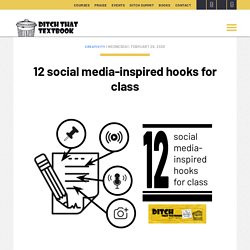
Distance Learning Webinars: Solutions for the 2020-21 School Year. IC3 1. 8 essential qualities of a digital literacy curriculum. Kids have trouble holding pencils, due to so much time on iPads. Experts say that children lack the muscle strength required to write.
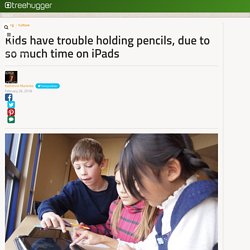
Children spend so much time swiping iPad screens that they cannot hold a pencil anymore. Senior paediatricians in the United Kingdom say that many children start school lacking the muscle strength to grip a pencil, which affects their ability to learn how to write properly. Sally Payne, head paediatric occupational therapist at the Heart of England foundation NHS Trust, told The Guardian: "Children are not coming into school with the hand strength and dexterity they had 10 years ago.
Children coming into school are being given a pencil but are increasingly not able to hold it because they don’t have the fundamental movement skills. " Developing finger, arm, and shoulder strength is something that happened naturally in the past, when children drew, colored, cut paper and did crafts for entertainment and participated more actively in household chores.
To Leverage Tech in Writing Instruction, This Superintendent Channeled Justin Bieber. Keynote Presentation Resources. Edutopia.
Stenhouse Publishers. Three Tips for Novice Bloggers. Posted by Bill Ferriter on Wednesday, 12/14/2016 Over the last several weeks, I've had the chance to connect with some really terrific teachers right here in my own county.
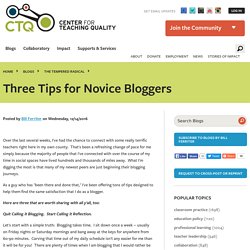
That's been a refreshing change of pace for me simply because the majority of people that I've connected with over the course of my time in social spaces have lived hundreds and thousands of miles away. What I'm digging the most is that many of my newest peers are just beginning their blogging journeys. As a guy who has "been there and done that," I've been offering tons of tips designed to help them find the same satisfaction that I do as a blogger.
Here are three that are worth sharing with all y'all, too: Quit Calling it Blogging. Edutopia. Process with Pencil and Paper, Produce with Technology – highfivehistory. Introducing the math selfie. Math selfies, QR codes, and Kahoot games enrich one school Sure, you may have taken a selfie, but you likely haven’t taken an equivalent fraction selfie — and if you ask the Jefferson Elementary School fourth-graders in Jennifer Moser’s fourth-grade math class, you haven’t really lived until you’ve snapped, uploaded and shared your share of equivalent fraction selfies.
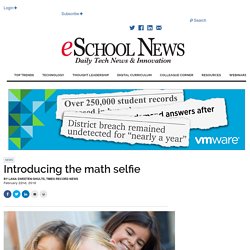
These high-tech, mathematically-savvy and, let’s face it, just plain cool selfies are just one way Wichita Falls ISD students are using digital technology in their classrooms as a way to enhance and enrich learning. Teams of administrators spent much of Wednesday visiting these classrooms, part of the District Classroom Pilot Program, as part of the nationwide Digital Technology Day.
Teachers want larger role in ed-tech decisions. “Nobody is better situated than classroom teachers when it comes to observing which education technologies are driving meaningful improvements to student learning outcomes,” says Bob Pianta, Dean of the Curry School of Education at the University of Virginia, and Chairman of the Jefferson Education Accelerator.
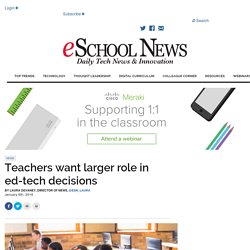
“Decisions about which ed-tech products and services should be in our classrooms should be heavily influenced by teachers who have access to evidence of their impact.” Forty-eight percent of respondents believe that cost is the number one influence on ed-tech selection, more so than student outcomes (22 percent) and teacher buy-in (9 percent). Just 12 percent of respondents say school-based technology experts currently make decisions, but 33 percent of respondents say they should play an important role (second only to teachers).
Forty-nine percent of those surveyed say parents should play the smallest decision-making role, with district leadership not far behind (24 percent). The advanced Google searches every student should know. Google has amazing tools for finding school-worthy sources.
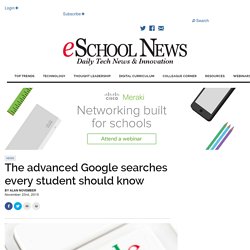
The advanced Google searches every student should know. The internet presents our students with the significant challenge of learning how to access and synthesize massive amounts of information from all over the world.

To manage overwhelming amounts of information, it is critical to learn how to design searches that take you past the first page of results. The quality of information can lead to a over simplification of an issue or lead to a much deeper understanding of the nuances of a topic. In today’s global economy, global empathy is one of the most critical skills we must teach our students. To this end, utilizing the internet strategically can lead students to understand other cultures and viewpoints and spark authentic learning experiences. While the internet provides us with the opportunity to explore issues from multiple perspectives and exposes our simplified narratives, the reality of how Google targets basic search often leads to localized results.
Let’s take a look at a detailed example assignment, “the Iranian Hostage Crisis.” The Benefits of Using GAFE with Primary Students. It feels like it was just yesterday that I introduced Google Apps for Education to my students (in reality, it has been about a year and a half!).

Needless to say, it has been a huge success for both my students and for myself. Part of the fun of integrating GAFE revolves around documenting and sharing our learning, so that others can benefit from our experiences. Straight from the DOE: Dispelling Myths About Blocked Sites. Over the past few weeks, I’ve been hearing from frustrated teachers about surprising websites their schools block — everything from National Geographic to Skype.
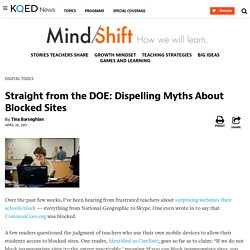
One even wrote in to say that CommonCore.org was blocked. A few readers questioned the judgment of teachers who use their own mobile devices to allow their students access to blocked sites. It’s late 2015 and we’re still overblocking the Internet It’s late 2015, we’re still overblocking the Internet, and the blame is on us as administrators… I read a post recently that stressed yet again how access to the wide range of the Internet is an equity issue.

Like library and textbook censorship, not only does blocking video services, social media, online interactive content, and other Web resources restrict students’ intellectual freedom, it also prohibits them from engaging in powerful conversations and learning opportunities (and, incidentally, also sends messages to your most technology-fluent educators that you’re outdated). Teacher Training Videos - Free online technology and ict tutorials for use in education. eSchool News Duncan: U.S. needs to modernize its schools. By Thomas E. Perez and Arne Duncan for The Philadelphia Inquirer September 7th, 2015 Today’s schools have to do a better job of teaching career-ready skills.
7 Awesome Tools Social Studies Teachers Can Use to Teach Geography. From King Louis XVI to President Herbert Hoover, Social Studies teachers introduce their students to leaders who resisted change. Rather than emulating these failed leaders, Social Studies teachers should model growth and evolution. This series of blog posts explains how Social Studies teachers can use educational technology to modernize and improve the student experience.
Today, we’re focusing on new and novel approaches to teaching geography. Creating, Using, and Understanding Maps. eSchool News This school is using 'Shark Tank' to teach research and presentation skills. By Trent Moore, The Cullman Times, Ala. August 25th, 2015. To put tech into any lesson, start with the lesson. By Tom Daccord June 1st, 2015. Ask these questions before using technology in the classroom. True tech integration starts with learning goals. Education Technologies and Concepts That Every Teacher Should Know: Part I - Education Futures: Emerging Trends and Technologies in K-12. The Information Era began some decades ago. Since its inception, though, it has dramatically changed the way we educate our children.
The Right & Wrong Way To Use Technology For Learning. So much in learning is subjective, which makes sense because so much in life itself is also subjective, and we learn in order to live. So it’s natural. Grey areas abound–the usefulness and quality of the Common Core Standards. The importance of curiosity in learning.
Ask these questions before using technology in the classroom. eSchool News 7 mobile learning myths no educator should believe. By Meris Stansbury, Managing Editor, @eSN_Meris August 5th, 2015. 7 Cyberlearning Technologies Transforming Education The year was 1984 and in addition to the chalkboards and alphabet posters, our 2nd grade classroom was equipped with an odd, beige box at a table in the back behind the students. Trudacot v2 annotated - Google Docs. 2015 trudacot overview - Google Docs. 50 Powerful Ways To Use Skype In The Classroom. The problem with the SAMR model.
By Trevor Shaw April 27th, 2015 It’s easy to get hung up on the definitions.
Undercover Teachers or Imaginary Friends? Nicholas was curious about my identity and the question I had posed to him. He clearly thought the notion of writing to me, a computer, was bizarre—yet he spoke to me with the easy irreverence of a boy addressing an imaginary friend. How to Grow a Classroom Culture That Supports Blended Learning. The excerpt below is from the book “Moonshots in Education: Launching Blended Learning in the Classroom,” by Esther Wojcicki, Lance Izumi and Alicia Chang. This excerpt is from the chapter entitled “Trick in the Blended Classroom,” written by Wojcicki.
A Teacher’s View on a Geeky “EdTech” Conference — Bright. Last week, I had the opportunity to attend the ASU/GSV Summit in Scottsdale, Arizona, the premier conference on educational technology (or “EdTech”). Over 2,500 innovators and entrepreneurs were in attendance, discussing new trends in iPad software and online curriculum. Amplifying Student Voice Through Digital Literacy. Kids Who Have to Share iPads Learn Better Than Kids Who Have Their Own. Set up your own digital media lab for next to nothing. School Technology Needs Assessment (STNA) - SERVE Center at the University of North Carolina at Greensboro.
Dr. Alice Christie's Workshops for Educators. Teachertechusagesurveyresults.pdf. Becoming a 21st Century School - Blog. Study demonstrates math program's impact on students. eSchool News Bricolage, MOSL and 8 soon-to-be-huge ed tech innovations. Page. Creators versus consumers – the new digital divide « Revolutionary Measures. Moving from Students as Consumers to Creators of Digital Content. Consumer to Creator (Two Years Later) - Youth Digital. Help Kids Become Responsible Digital Citizens. Evaluating Software From a Learning-Theory Perspective. Vstevideo. 2013-horizon-report-k12.pdf (application/pdf Object) Educational Technology: A Definition with Commentary. 25 Teaching Tools To Organize, Innovate, & Manage Your Classroom. The 10 Most Popular Teacher Tools Being Used This Year.
Using video to improve teaching and learning. Three ways social studies teachers use tech. Twelve learning technologies with big education potential. 10 ed-tech tools of the 70s, 80s, and 90s. 101 Ways to Use Tagxedo. How to create a student-centered digital classroom - eClassroom News. Beyond Words: How Generation Y is Redefining Learning For Everyone. The Classroom of 2024: Four future hallmarks. 8 digital learning myths dispelled. What We Really Need To Know About Ed Tech. Digital Native Students are More Consumers than Creators. 55 Content Curation Tools To Discover & Share Digital Content. 8 innovative ideas for the tech-strapped teacher. (Vine + Vimeo) X (Macbeth + Make-believe) X (Costumes + Cadence) = Engaging Excercise — Small Teacher. Big World. 20 Ways To Use Twitter's Vine In Education.
How To Make an Animated GIF.